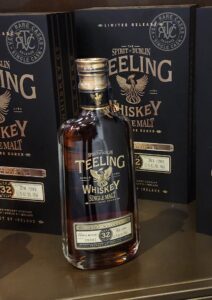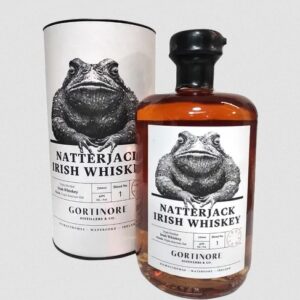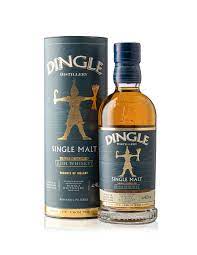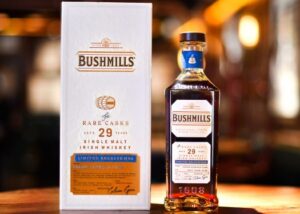By Richard Thomas
Although some ignore it or limit their participation to wearing something green, many mark St. Patrick’s Day with our own little tweaks on the holiday. I put out a bottle of Irish Whiskey on the shelf (to be shared with what guests come calling) on March 1st every year, and make things like lamb shepherd’s pie topped with colcannon. But one thing I encourage readers to do is make a point of trying a new Irish Whiskey, either by picking up a bottle at the store or keeping an eye out at the bar. Indeed, the only reason I don’t do this myself is that this gig calls on me to try new Irish Whiskeys year around!
All of these whiskeys have come into distribution since St. Patrick’s Day 2022. Slainte!
Bottles To Fit A Budget
The Bird from Flying Tumbler ($32): First and cheapest of these bottles to fit a budget is this expression from an independent, family-owned negociant company, Flying Tumbler. The Bird is part of a trio of current bottlings from Flying Tumbler (the other two are The Tippler and The Roller), and the one you are most likely to be able to find in the U.S. It’s a classic Irish blend of triple distilled grain and malt whiskeys coming from two distinct batches. One batch is married in ex-Oloroso Sherry casks, and the other in ex-bourbon barrels, and after the marriage and finishing, these two batches are brought together.
Keeper’s Heart Irish + Bourbon ($45): I think the obvious joke here is that instead of being Irish-American, this whiskey is Irish + American. It’s an international hybrid of American bourbon and imported Irish pot still and grain whiskeys, done by O’Shaughnessy Distillery in Minneapolis. The O’Shaughnesseys were fortunate to acquire the services of Brian Nation, former Master Distiller of New Midleton, and David Perkins, the founder of High West Distillery. Between those two, one has a truly expert base of knowledge for making a sourced, hybrid whiskey of this kind, and the bourbon in the mix should be an obvious hook for any skeptical stick-in-the-mud types.
Natterjack Irish Whiskey ($40): This is a triple-distilled, blended Irish Whiskey of unknown sourcing (although the triple distilled part rules out Cooley). The finish in new American oak casks gives it a special bit of polish, and keeping that in mind, it’s a better and more novel choice than a standard like Jameson or Bushmills White Label.
Mid-Range Bottles
Dingle Single Malt ($60): I know what you’re thinking, because you are a sharp whiskey enthusiast: “Dingle Single Malt isn’t new.” Although the West Irish distillery has a series of limited edition, single-shot releases going back years, this regular release single malt is a new creature. Initially released on the other side of the Atlantic in 2021, it only arrived on American shores the next year. Insofar as mid-range Irish single malts go, it’s spot on.
Gold Spot Single Pot Still ($105): Speaking of spots, the latest expression from The Spots line of single pot still whiskeys came out in this interval between St. Patrick’s Days. Briefly, pot still whiskey is made using a distinctly Irish wort of malted and unmalted barley, and sometimes rye. The class is noted for its rich, spicy character. The Spots line is basically a collaboration between New Midleton (which makes the whiskey) and the negociant who originated the brand, and is named for colored spots. For a long time, The Spots were the only surviving example of single pot still whiskey on the market, back during the nadir of Irish Whiskey and before Redbreast was introduced. Gold Spot is a 9 year old is bottled at the relatively strong 51.4% ABV.
Waterford Heritage Hunter ($110): This single malt from Waterford Distillery is the product of a long-term agricultural-cum-distilling experiment, aimed at reviving heirloom barley varietals for use in whiskey-making. This is named for Dr. Herbert Hunter, who introduced a barley varietal in 1959 that was praised for its flavorful qualities. Since the middle 20th Century, farmers moved away from these heirloom varietals and towards types that produce higher (if often blander) yields. As many American distillers have also discovered, the first problem in using heirloom grain is getting enough of it to work with; the Hunter barley started from a mere 50 gram sample of seed, and had to be built up over years of planting and harvesting to produce enough yield grain for a production run. The result of all this effort has created quite a buzz in Irish Whiskey circles, so try it if you can find it.
Bottles To Splurge On
Teeling 32 Year Old Single Malt ($3,500): This is what I wrote about this bottle when I named it “Best Whiskey To Pass My Lips In 2022:”
The Whiskey Reviewer hands out an A+ grade to a whiskey every now and again, but speaking for myself and not my team, I rarely do. So rarely, in fact, I had to look up the last time I did so: it was five years ago!
Teeling Whiskey Company took 28 year old Irish single malt, acquired what must have been an excellent Purple Muscat from Setubal in Portugal, and gave that whiskey an extra four years of secondary maturation. The result was ambrosia. The five years since I last gave an A+ have been busy, and saw me produce five books about booze and countless articles for other websites and magazines, on top of my own website. So take that into consideration and know that when I call it a drink worthy of the gods, I mean it.
Bushmills Rare Cask 29 Year Old Pedro Ximenez Cask Single Malt ($500): This second installment in the Bushmills Rare Cask series isn’t merely finished in Pedro Ximenez (PX) Sherry casks. Well, technically it is finished in them, but how often is a round of secondary maturation longer than the primary maturation? The malt whiskey going into this bottling spent 12 years in ex-bourbon barrels, and then 17 years in the PX casks.
 The Whiskey Reviewer A World of Whiskey, Poured Every Weekday
The Whiskey Reviewer A World of Whiskey, Poured Every Weekday




